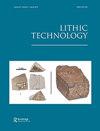The Influence of Tool Morphology on Visual Attention During the Interaction with Lower Palaeolithic Stone Tools
IF 1.2
3区 社会学
Q2 ANTHROPOLOGY
引用次数: 0
Abstract
ABSTRACT Humans are specialized in eye-hand coordination through a complex visuospatial system. When a tool is observed, the motor areas of the brain are activated and, when grasped, it is sensed as a part of the body. One approach to understanding the underlying mechanisms behind this process regards the analysis of visual attention. Vision influences the spatial interaction with tools and plays a crucial role in the perception of an object’s affordances. In this study, we employ eye-tracking technology to investigate whether Lower Palaeolithic stone tool morphology influences visual attention during visual exploration and manipulation. Our results suggest that the handaxe morphology has a moderate influence on the visual scanning of the tool. In contrast, visual exploration of the chopper is only influenced by the weight of the tool. The different visual behaviours exerted by these two technologies suggest divergences in the visuospatial process underlying the interaction with these tools.旧石器时代晚期石器交互作用中工具形态对视觉注意的影响
摘要人类通过复杂的视觉空间系统来进行眼手协调。当观察到工具时,大脑的运动区域会被激活,当被抓住时,它会被感知为身体的一部分。理解这一过程背后的潜在机制的一种方法是对视觉注意力的分析。视觉影响与工具的空间互动,并在感知物体的可供性方面发挥着至关重要的作用。在这项研究中,我们使用眼动追踪技术来研究旧石器时代晚期的石器形态是否会影响视觉探索和操作过程中的视觉注意力。我们的结果表明,手斧形态对工具的视觉扫描有适度的影响。相比之下,斩波器的视觉探索仅受工具重量的影响。这两种技术所产生的不同视觉行为表明,与这些工具交互的视觉空间过程存在差异。
本文章由计算机程序翻译,如有差异,请以英文原文为准。
求助全文
约1分钟内获得全文
求助全文

 求助内容:
求助内容: 应助结果提醒方式:
应助结果提醒方式:


